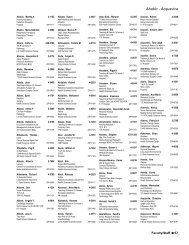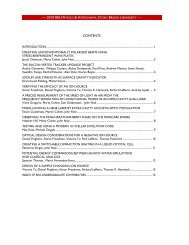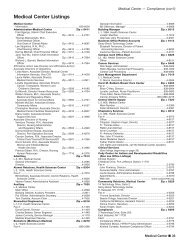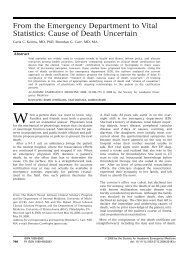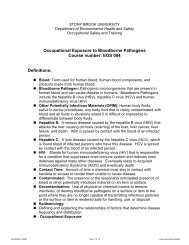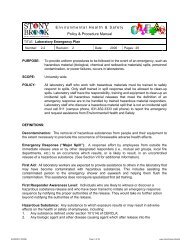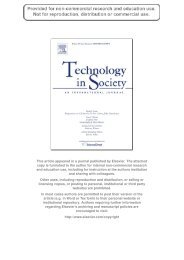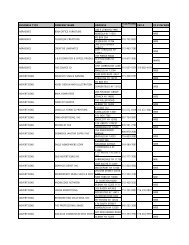Radiation Emergency Spill Procedures - Stony Brook University
Radiation Emergency Spill Procedures - Stony Brook University
Radiation Emergency Spill Procedures - Stony Brook University
You also want an ePaper? Increase the reach of your titles
YUMPU automatically turns print PDFs into web optimized ePapers that Google loves.
Environmental Health and Safety Manual<br />
Title: <strong>Radiation</strong> <strong>Emergency</strong> <strong>Spill</strong> <strong>Procedures</strong><br />
Policy Number: EH&S 6-7<br />
Effective Date: 9/91 Revision: 2/97 Number of Pages: 4<br />
PURPOSE:<br />
SCOPE:<br />
To establish procedures to be followed in the event of a radiation emergency.<br />
<strong>University</strong> wide.<br />
PROCEDURES:<br />
I. Accidental <strong>Spill</strong>s of Radioisotopes<br />
1. Depending on the quantity and radiotoxicity of the material involved, spills may be<br />
divided into two general categories: 1) minor spills, involving minimal hazard potential,<br />
and 2) major spills, involving significant exposure potential. See Appendix A for a<br />
guide to assessing the hazard potential of spills.<br />
II.<br />
Minor <strong>Spill</strong>s<br />
1. Notify all personnel of the accident and restrict access to the contaminated area until<br />
the Department of Environmental Health and Safety <strong>Radiation</strong> Safety Officer arrives.<br />
2. Individuals who may have been contaminated should be taken to a nearby<br />
contamination free area for evaluation.<br />
3. Contact Public Safety at 333 and request the <strong>Radiation</strong> Safety Officer. Be sure to<br />
specify that the emergency involves ionizing radiation and provide specifics on what<br />
happened.<br />
4. If appropriate instrumentation is available, an evaluation should be made of personnel<br />
contamination.<br />
a. If contamination is found on clothing, the clothing should be removed and held<br />
for evaluation by the <strong>Radiation</strong> Safety Officer.<br />
b. If skin is contaminated, wash with detergent and water, or shower, if facilities<br />
are available. Resurvey after washing.<br />
5. Confine the spill as soon as possible. Before proceeding, however, individuals must<br />
EHSD0241 (02/97) Page 1 of 5 www.stonybrook.edu/ehs
TITLE: Radioactive <strong>Emergency</strong> <strong>Spill</strong> <strong>Procedures</strong> POLICY: 6-7<br />
obtain protective clothing (disposable gloves, goggles, lab coats or coveralls, shoe<br />
covers, and if necessary, respirators). Ask the <strong>Radiation</strong> Safety Officer for necessary<br />
decontamination materials if they are not available in the laboratory.<br />
6. Before proceeding with clean-up, use an ionization survey instrument to evaluate<br />
external radiation levels.<br />
7. Clean up the spill using a detergent and water (commercial decontamination agents are<br />
available). In the case of liquid spills, use absorbent paper or granular solid absorbent<br />
on the spill, and deposit soaked clean-up material in a radioactive waste container or<br />
plastic bag. If the spill is a powder or dry material, moisten carefully before clean-up in<br />
order to prevent airborne activity.<br />
8. Continue decontamination until no removable activity is detected by smear method.<br />
9. Monitor all persons involved in the clean-up and make sure that everyone is clean<br />
before leaving the area.<br />
10. Prepare a written report of the incident and list the individuals involved. The survey<br />
results must be included and a copy sent to the <strong>Radiation</strong> Safety Officer within the<br />
week.<br />
III.<br />
Major <strong>Spill</strong>s<br />
1. Notify all personnel of the accident and restrict access to the contaminated area until<br />
the Department of Environmental Health and Safety <strong>Radiation</strong> Safety Officer arrives.<br />
2. Individuals who may have been contaminated should be taken to a nearby<br />
contamination free area for an evaluation.<br />
3. Contact Public Safety at 333 and request the <strong>Radiation</strong> Safety Officer. Be sure to<br />
specify that the emergency involves ionizing radiation and provide details about what<br />
happened.<br />
4. If contamination is apparent by measurement or observation, remove clothing and<br />
shower. After shower, resurvey to determine the need for further decontamination, if<br />
any. Hold all contaminated items for the <strong>Radiation</strong> Safety Officer.<br />
5. Do not decontaminate the area until the <strong>Radiation</strong> Safety Officer arrives. The facility<br />
should be secured to prevent unauthorized access.<br />
-Rev. 2/97-<br />
EHSD0241 (02/97) Page 2 of 5 www.stonybrook.edu/ehs
TITLE: Radioactive <strong>Emergency</strong> <strong>Spill</strong> <strong>Procedures</strong> POLICY: 6-7<br />
6. Permit no person to resume work in the area until the <strong>Radiation</strong> Safety Officer has<br />
made a final survey and given approval for reoccupancy.<br />
7. Prepare a complete written report of the accident and list the individuals involved. A<br />
copy must be sent to the <strong>Radiation</strong> Safety Officer within one week.<br />
IV.<br />
General Decontamination <strong>Procedures</strong> for Personnel<br />
1. For decontaminating skin surfaces, it is most effective to begin with simple washing<br />
procedure and progress to more involved procedures until the contamination is<br />
reduced to an acceptable level. The following is a list of the decontamination sequence:<br />
a. Wash with water and detergent<br />
b. Scrub with water and detergent<br />
c. Treat with chemical cleaning agents<br />
2. Between each step of the procedure the contaminated area should be checked to<br />
determine if contamination is still present.<br />
3. Chemical treatment is to be used only when absolutely necessary, and then only under<br />
the direction of the <strong>Radiation</strong> Safety Officer.<br />
V. Radioisotope <strong>Spill</strong>s Involving Other Hazardous Agents<br />
1. If a spill involves other hazardous agents in combination with a radioactive material<br />
such as toxic or flammable chemicals, carcinogenic chemicals, or pathogenic microorganisms<br />
(viruses, bacteria), the <strong>Radiation</strong> Safety Officer should be advised and will<br />
recommend special decontamination procedures and equipment necessary for<br />
personnel safety.<br />
VI.<br />
Lost <strong>Radiation</strong> Sources<br />
1. If sealed radiation sources are lost or misplaced, the <strong>Radiation</strong> Safety Officer must be<br />
contacted immediately. The longer the source is missing, the more difficult it will be to<br />
locate, and greater the potential hazard to personnel.<br />
2. Caution must be exercised in recovering a lost source to avoid unnecessary personnel<br />
exposure. The source encapsulation may have become ruptured, or the source capsule<br />
-Rev. 2/97-<br />
EHSD0241 (02/97) Page 3 of 5 www.stonybrook.edu/ehs
TITLE: Radioactive <strong>Emergency</strong> <strong>Spill</strong> <strong>Procedures</strong> POLICY: 6-7<br />
may have fallen out of the protective shield. Adequate monitoring instrumentation,<br />
provided by the <strong>Radiation</strong> Safety Officer, is necessary to properly evaluate such<br />
potential hazards.<br />
INQUIRIES/REQUESTS:<br />
RELATED FORMS:<br />
RELATED DOCUMENTS:<br />
Environmental Health and Safety<br />
110 Suffolk Hall<br />
Zip 6200<br />
Main Office: 632-6410<br />
FAX: 632-9683<br />
-Rev. 2/97-<br />
EHSD0241 (02/97) Page 4 of 5 www.stonybrook.edu/ehs
TITLE: Radioactive <strong>Emergency</strong> <strong>Spill</strong> <strong>Procedures</strong> POLICY: 6-7<br />
APPENDIX A<br />
Assessing <strong>Spill</strong>s: Hazards of Radioactive Materials<br />
Low Hazard<br />
Above 1 mCi, treat as a major spill<br />
H-3, Be-7, C-14, F-18, Ni-59, Zn-69, Ge-71, U-238, Natural Thorium, Natural Uranium, Noble<br />
Gases.<br />
Medium Hazard<br />
Above 100 uCi, treat as a major spill<br />
C-14, Na-24, Si-31, P-32, S-35, Cl-36, K-42, V-48, Cr-51, Mn-54, Mn-56, Fe-55, Fe-59, Cu-64, Zn-<br />
65, Ga-72, As-76, Pb-86, Sr-89, Y-90, Y-91, Zr-95, Nb-95, Mo-99, Ru-103, Rh-105, Pb-10b, Ag-<br />
105, Ag-111, Cd-109, Sn-113, Te-127, mTe-129, Ba-140, La-140, Pr-143, Pm-147, Sm-151, Ho-166,<br />
Tm-170, Lu-177, Re-183, Ir-190, Pt-191, Pt-193, Au-196, Au-198, Au-199, Tl-200, Tl-201, Tl-202,<br />
Tl-204, Pb-203, Rn-220, Rn-222, U-135.<br />
High Hazard<br />
Above 10 uCi, treat as a major spill<br />
Na-22, Ca-45, Sc-46, Co-60, Sr-90, Ru-106, I-129, I-131, Cs-137, Ce-144, Eu-154, Ta-182, Bi-210,<br />
At-211, Ra-224, U-233.<br />
Very High Hazard<br />
Above 10 uCi, treat as a major spill<br />
Pb-210, Po-210, Ra-226, Ra-228, Ac-227, Th-228, Th-230, Np-237, Pu-238, Pu-239, Pu-240, Pu-<br />
241, Pu-242, Am-241, Cm-242.<br />
-Rev. 2/97-<br />
EHSD0241 (02/97) Page 5 of 5 www.stonybrook.edu/ehs



